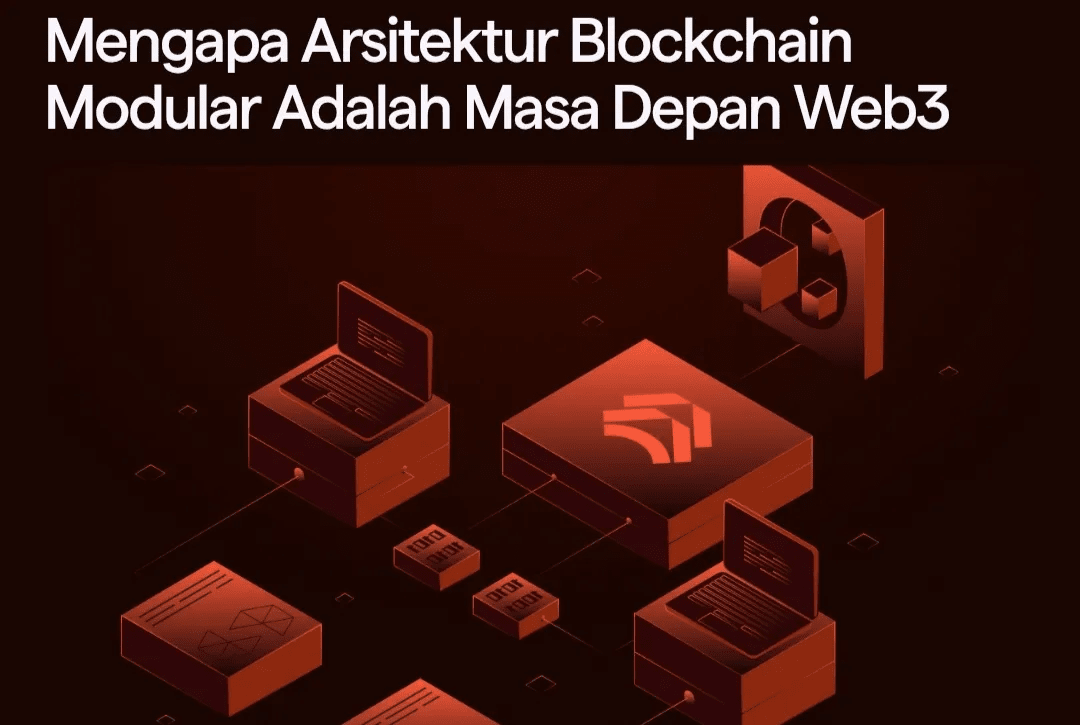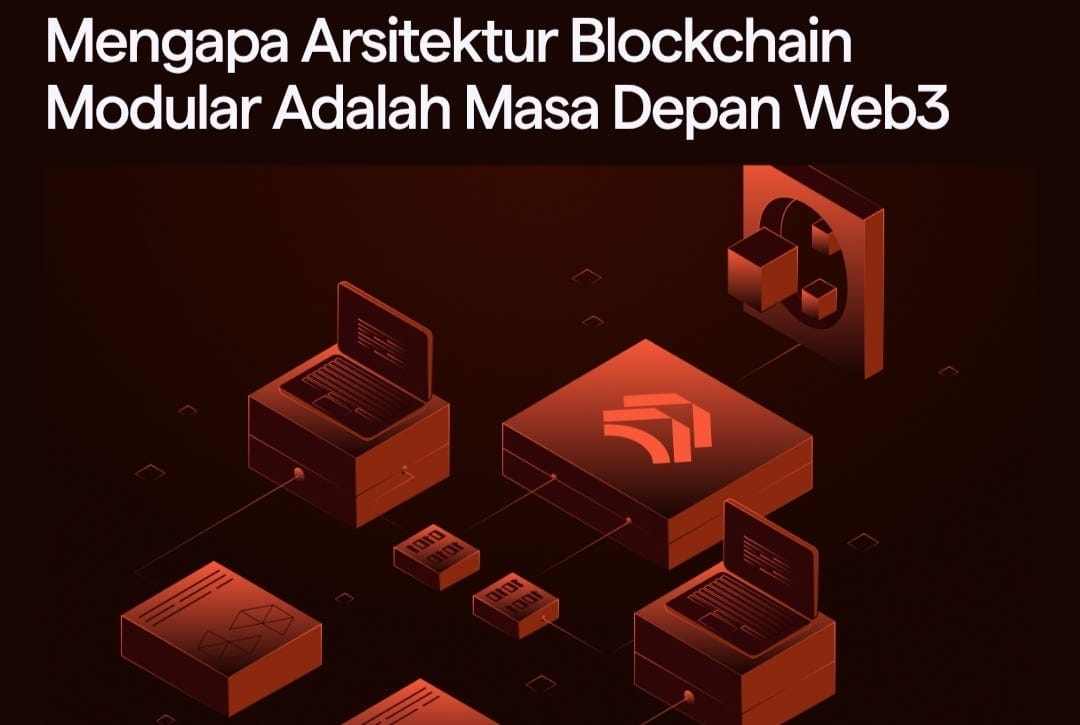
Modular blockchain architecture emerges as the most scalable, flexible, and future-proof design for Web3 infrastructure.
By separating core functions like execution, consensus, settlement, and data availability, modular systems enable faster innovation and more adaptable blockchain ecosystems compared to traditional monolithic chains.
Key benefits include:
Scalability without compromising security
Custom optimizations for various use cases
Enhanced interoperability and composability
Faster development cycles and reduced technical debt

Introduction — Infrastructure Barriers of Web3
Current Web3 infrastructure faces fundamental architectural challenges that hinder mainstream adoption. Traditional monolithic blockchains try to do everything at once — handling execution, consensus, settlement, and data availability in a tightly interconnected system. This 'one size fits all' approach has created insurmountable barriers.
Ethereum processes about 15 transactions per second. Bitcoin manages around 7 transactions. Meanwhile, traditional payment processors like Visa handle 65,000 TPS during peak loads. This is not just a performance gap — it represents a fundamental architectural limitation that constrains the potential of Web3.
The problem runs deeper than just throughput. Monolithic design imposes tough choices between security, scalability, and decentralization. Fixing one aspect often sacrifices another, creating accumulated technical debt over time.
Modular blockchain architecture represents a paradigm shift that breaks these limitations by separating blockchain functions into specialized layers. Rather than forcing every component to optimize for the same goals, modular systems allow each layer to excel in its specific objectives while maintaining seamless integration with other components.
The evolution of this architecture is not just theoretical — it has reshaped the way we build Web3 infrastructure and unlocked capabilities that were previously impossible with monolithic designs.
What is Modular Blockchain Architecture?
Modular blockchain architecture separates traditional blockchain functions into specialized layers that can be developed, optimized, and upgraded independently. Rather than handling execution, consensus, settlement, and data availability in a single system, modular design distributes these responsibilities across dedicated components.
This separation allows for unprecedented flexibility and optimization. Each layer can use the most appropriate technology for its specific needs, rather than compromising to fit within a monolithic framework.
Breaking Down the Layers
Modular blockchain systems are typically divided into four core layers:
Execution Layer: Processes transactions and runs smart contracts. This layer handles the computational work of blockchain applications, from simple token transfers to complex DeFi operations. By specializing in execution, this layer can implement advanced optimizations such as parallel processing, specialized virtual machines, or application-specific optimizations.
Settlement Layer: Provides final settlement and dispute resolution for transactions processed on the execution layer. The settlement layer offers strong security guarantees and serves as the main source of truth for cross-layer interactions. They handle cryptographic proofs and economic incentives that ensure executed transactions remain immutable.
Consensus Layer: Coordinates network participants to agree on the canonical state of the blockchain. This layer focuses purely on achieving distributed consensus without being burdened by execution complexities. Specialized consensus mechanisms can optimize various priorities such as speed, energy efficiency, or Byzantine fault tolerance.
Data Availability Layer: Ensures that transaction data remains accessible to network participants for verification and historical reference. The data availability layer addresses the crucial problem of ensuring that execution results can be independently verified without requiring every node to store the complete transaction history.
Modular vs Monolithic Blockchain
The contrast between modular and monolithic approaches reveals fundamental differences in design philosophy and capabilities.
Monolithic blockchains integrate all functions into a single system where consensus nodes must execute every transaction, store all data, and participate in every aspect of network operations. This creates inherent limitations: execution complexity directly impacts consensus speed, storage requirements grow linearly with network usage, and optimization efforts must balance competing priorities across all functions.
Modular blockchains distribute responsibilities across specialized layers that communicate through well-defined interfaces. Each layer can optimize independently: execution layers can implement cutting-edge virtual machines, consensus layers can experiment with new algorithms, and data availability layers can leverage specialized storage techniques.
Key advantages of modular design:
Scalability: Each layer scales according to its specific needs.
Flexibility: Components can be swapped or upgraded without changes across the system.
Specialization: Custom optimizations made for each function.
Speed of Innovation: Independent development cycles accelerate improvements.
Cost Efficiency: Resources are allocated where they provide maximum value.
This modularity allows blockchain systems to scale and adapt to changing needs without accumulating technical debt that often occurs in monolithic architectures.
Why Modular Architecture Solves Core Web3 Problems
Modular blockchain architecture directly addresses the fundamental limitations that have hindered the growth of Web3 by enabling systems to optimize multiple goals simultaneously rather than accepting trade-offs among those goals.
Scalability Without Compromising Security
Traditional blockchain design imposes a direct choice between scalability and security. Modular architecture breaks this limitation by separating execution from consensus, allowing each to scale independently while maintaining strong security guarantees.
Execution layers can achieve tremendous outcomes by applying advanced techniques such as parallel processing, optimistic execution, or application-specific optimizations. Meanwhile, the settlement layer provides strong security through proven consensus mechanisms and economic incentives, without being limited by execution complexities.
Rollup technology is an example of this approach. Optimistic rollups process thousands of transactions per second off-chain while inheriting Ethereum's security through periodic settlements. ZK rollups achieve similar scalability with cryptographic proofs enabling instant finality. Both approaches achieve throughput increases of 100x+ while maintaining the security properties of the underlying settlement layer.
Shared security models enhance these benefits by allowing multiple execution layers to leverage the same consensus infrastructure. A single highly secure consensus layer can support dozens of specialized execution environments, each optimized for different use cases while benefiting from shared security guarantees.
Search
Write


Emperor
9 min read
·
Jun 10, 2025

Modular blockchain architecture emerges as the most scalable, flexible, and future-proof design for Web3 infrastructure.
By separating core functions like execution, consensus, settlement, and data availability, modular systems enable faster innovation and more adaptable blockchain ecosystems compared to traditional monolithic chains.
Key benefits include:
Scalability without compromising security
Custom optimizations for various use cases
Enhanced interoperability and composability
Faster development cycles and reduced technical debt

Introduction — Infrastructure Barriers of Web3
Current Web3 infrastructure faces fundamental architectural challenges that hinder mainstream adoption. Traditional monolithic blockchains try to do everything at once — handling execution, consensus, settlement, and data availability in a tightly interconnected system. This 'one size fits all' approach has created insurmountable barriers.
Ethereum processes about 15 transactions per second. Bitcoin manages around 7 transactions. Meanwhile, traditional payment processors like Visa handle 65,000 TPS during peak loads. This is not just a performance gap — it represents a fundamental architectural limitation that constrains the potential of Web3.
The problem runs deeper than just throughput. Monolithic design imposes tough choices between security, scalability, and decentralization. Fixing one aspect often sacrifices another, creating accumulated technical debt over time.
Modular blockchain architecture represents a paradigm shift that breaks these limitations by separating blockchain functions into specialized layers. Rather than forcing every component to optimize for the same goals, modular systems allow each layer to excel in its specific objectives while maintaining seamless integration with other components.
The evolution of this architecture is not just theoretical — it has reshaped the way we build Web3 infrastructure and unlocked capabilities that were previously impossible with monolithic designs.
What is Modular Blockchain Architecture?
Modular blockchain architecture separates traditional blockchain functions into specialized layers that can be developed, optimized, and upgraded independently. Rather than handling execution, consensus, settlement, and data availability in a single system, modular design distributes these responsibilities across dedicated components.
This separation allows for unprecedented flexibility and optimization. Each layer can use the most appropriate technology for its specific needs, rather than compromising to fit within a monolithic framework.
Breaking Down the Layers
Modular blockchain systems are typically divided into four core layers:
Execution Layer: Processes transactions and runs smart contracts. This layer handles the computational work of blockchain applications, from simple token transfers to complex DeFi operations. By specializing in execution, this layer can implement advanced optimizations such as parallel processing, specialized virtual machines, or application-specific optimizations.
Settlement Layer: Provides final settlement and dispute resolution for transactions processed on the execution layer. The settlement layer offers strong security guarantees and serves as the main source of truth for cross-layer interactions. They handle cryptographic proofs and economic incentives that ensure executed transactions remain immutable.
Consensus Layer: Coordinates network participants to agree on the canonical state of the blockchain. This layer focuses purely on achieving distributed consensus without being burdened by execution complexities. Specialized consensus mechanisms can optimize various priorities such as speed, energy efficiency, or Byzantine fault tolerance.
Data Availability Layer: Ensures that transaction data remains accessible to network participants for verification and historical reference. The data availability layer addresses the crucial problem of ensuring that execution results can be independently verified without requiring every node to store the complete transaction history.
Modular vs Monolithic Blockchain
The contrast between modular and monolithic approaches reveals fundamental differences in design philosophy and capabilities.
Monolithic blockchains integrate all functions into a single system where consensus nodes must execute every transaction, store all data, and participate in every aspect of network operations. This creates inherent limitations: execution complexity directly impacts consensus speed, storage requirements grow linearly with network usage, and optimization efforts must balance competing priorities across all functions.
Modular blockchains distribute responsibilities across specialized layers that communicate through well-defined interfaces. Each layer can optimize independently: execution layers can implement cutting-edge virtual machines, consensus layers can experiment with new algorithms, and data availability layers can leverage specialized storage techniques.
Key advantages of modular design:
Scalability: Each layer scales according to its specific needs.
Flexibility: Components can be swapped or upgraded without changes across the system.
Specialization: Custom optimizations made for each function.
Speed of Innovation: Independent development cycles accelerate improvements.
Cost Efficiency: Resources are allocated where they provide maximum value.
This modularity allows blockchain systems to scale and adapt to changing needs without accumulating technical debt that often occurs in monolithic architectures.
Why Modular Architecture Solves Core Web3 Problems
Modular blockchain architecture directly addresses the fundamental limitations that have hindered the growth of Web3 by enabling systems to optimize multiple goals simultaneously rather than accepting trade-offs among those goals.
Scalability Without Compromising Security
Traditional blockchain design imposes a direct choice between scalability and security. Modular architecture breaks this limitation by separating execution from consensus, allowing each to scale independently while maintaining strong security guarantees.
Execution layers can achieve tremendous outcomes by applying advanced techniques such as parallel processing, optimistic execution, or application-specific optimizations. Meanwhile, the settlement layer provides strong security through proven consensus mechanisms and economic incentives, without being limited by execution complexities.
Rollup technology is an example of this approach. Optimistic rollups process thousands of transactions per second off-chain while inheriting Ethereum's security through periodic settlements. ZK rollups achieve similar scalability with cryptographic proofs enabling instant finality. Both approaches achieve throughput increases of 100x+ while maintaining the security properties of the underlying settlement layer.
Shared security models enhance these benefits by allowing multiple execution layers to leverage the same consensus infrastructure. A single highly secure consensus layer can support dozens of specialized execution environments, each optimized for different use cases while benefiting from shared security guarantees.
Flexibility and Specialization
Modular design allows for unprecedented flexibility in system composition. Developers can mix and match components to create an optimized stack tailored to specific needs, rather than accepting the constraints of monolithic designs.
Gaming applications benefit from execution layers optimized for low-value, high-frequency transactions with specialized state management for game assets. DeFi protocols can leverage execution environments with advanced financial primitives and MEV protection. Enterprise applications can utilize execution layers focused on privacy with allowed compliance and access control features.
This specialization extends to every layer of the stack. Data availability layers can optimize various trade-offs between cost, latency, and decentralization. Consensus layers can implement tailored mechanisms for specific network topologies or trust assumptions. Settlement layers can provide different finality guarantees based on application requirements.
The result is a blockchain infrastructure that adapts to applications, not forcing applications to adapt to the limitations of the infrastructure. This flexibility accelerates innovation by removing architectural constraints that previously limited what developers could build.
Interoperability and Composability
Modular systems inherently support better interoperability because they are built on standard interfaces between layers. These interfaces enable seamless communication between different blockchain systems and create opportunities for composable applications that span various execution environments.
The data availability layer serves as a shared infrastructure that can be utilized by multiple execution layers, creating a natural integration point for cross-chain communication. When various rollups share the same data availability layer, they can interoperate more easily because they have access to each other's transaction data and can implement efficient bridging mechanisms.
Shared settlement layers create additional composability opportunities. Applications deployed on different execution layers can interact through the settlement layer, enabling complex multichain workflows without the security compromises typically associated with cross-chain bridges.
This composability extends to developer tools and infrastructure. Modular systems can share monitoring tools, development frameworks, and operational infrastructure across layers, reducing the burden associated with building and maintaining blockchain applications.
The Modular Ecosystem in the Wild
The implementation of modular blockchain architecture in the real world has demonstrated the practical benefits of this approach, with several projects pioneering various aspects of modular design and proving that theoretical advantages translate into measurable improvements.
Celestia — Pioneer of the Data Availability Layer
Celestia represents the first blockchain specifically designed as a data availability layer, separating data availability from execution and consensus to create a dedicated infrastructure that can be leveraged by other blockchains.
Celestia's approach focuses purely on ordering and publishing transaction data without executing the transactions themselves. This specialization allows for significant optimizations: the network can achieve high throughput for data publication, implement efficient data sampling techniques for lightweight clients, and provide strong availability guarantees without the computational burden of executing transactions.
The benefits extend beyond Celestia itself. Rollups and other execution layers can use Celestia as their data availability provider, gaining access to specialized infrastructure without building their own data availability systems. This creates a separation of concerns where execution layers focus on transaction processing while Celestia handles data availability.
Celestia's data availability sampling allows lightweight clients to verify data availability without downloading entire blocks, addressing one of the fundamental scalability challenges in blockchain systems. This innovation enables the participation of a large number of nodes in data availability verification economically, thereby enhancing decentralization while maintaining efficiency.
The modular approach has allowed Celestia to specifically optimize data availability requirements, implementing features such as namespace-based data organization and fraud proofs for data availability that are impractical in monolithic designs.
Ethereum's Transition to Modularity
The evolution of Ethereum is one of the most significant transitions from monolithic to modular architecture in blockchain history. Rather than redesigning from scratch, Ethereum has gradually adopted modular principles through Layer 2 integrations and planned protocol upgrades.
The rollup-centric roadmap treats Ethereum's mainnet as a settlement and data availability layer while moving execution to specialized Layer 2 systems. This approach maintains Ethereum's security and decentralization while allowing for massive scalability improvements through modular design.
Optimistic rollups like Arbitrum and Optimism demonstrate how execution can be separated from consensus while maintaining security through fraud proofs and dispute resolution on the settlement layer. ZK rollups like Polygon zkEVM and zkSync show how cryptographic proofs can enable instant finality while inheriting the security of the base layer.
Ethereum's planned upgrades further include modularity. Proto-danksharding and full danksharding will transform Ethereum into a more efficient data availability layer while maintaining its role as a settlement layer for rollups. These upgrades specifically optimize modular use cases rather than trying to improve monolithic execution performance.
This transition shows that modular architecture is not just for new blockchains — existing systems can evolve towards modularity to unlock significant benefits without disregarding existing infrastructure and ecosystem investments.
Why Modular Infrastructure Is the Future of Web3
The fundamental advantages of modular blockchain architecture position it as the dominant design paradigm for the next growth phase of Web3. As the industry matures from experimental applications to widespread adoption, the flexibility and efficiency of modular systems become increasingly important.
Scalability requirements will increasingly grow as Web3 applications attract larger user bases and more sophisticated use cases. Monolithic designs have reached their scalability limits, while modular systems can continue to improve through specialization and layer-specific optimizations. The ability to scale different functions independently ensures that modular systems can adapt to changing demand patterns.
The speed of innovation supports a modular approach because upgrades can be implemented incrementally without system-wide updates. New virtual machines, consensus mechanisms, or data availability techniques can be integrated into modular systems without disrupting existing applications or requiring coordinated hard forks across the ecosystem.
Economic efficiency drives the adoption of modular designs as they eliminate redundant infrastructure and allow resource sharing across various applications. Shared data availability and settlement layers reduce the cost of launching new blockchain applications while providing enterprise-grade security and reliability.
Improving the developer experience in modular systems accelerates ecosystem growth by reducing complexity in building blockchain applications. Standardized interfaces between layers allow developers to focus on application logic rather than infrastructure issues, while specialized tools for each layer provide better debugging and optimization capabilities.
Compliance with regulations becomes easier to manage in modular systems where privacy, compliance, and governance features can be implemented at the appropriate layers without compromising the overall system. This flexibility is crucial for enterprise adoption and regulatory clarity across jurisdictions.
The convergence of these factors creates a compelling case that modular architecture represents the natural evolution of blockchain technology towards more efficient, flexible, and scalable systems.
Final Thoughts — Building with Modularity in Mind
The future of Web3 depends on an architectural foundation that can adapt and grow alongside the explosive growth we see across decentralized applications, digital assets, and blockchain-based services.
Modular blockchain architecture is not just a technical improvement — it is a fundamental shift towards a more efficient, flexible, and scalable Web3 infrastructure that opens possibilities previously constrained by monolithic limitations.
Whether you're building a DeFi protocol, a gaming application, or an enterprise blockchain solution, modular design principles provide a foundation for applications that can scale to user demand while maintaining security and decentralization.
At Altius Labs, we build high-performance execution infrastructure that supports the next generation of modular blockchain systems. Our parallel execution technology enables the throughput and efficiency that modular architecture needs to reach its full potential.
The modular revolution is happening right now. Projects that adopt modular principles today will have a significant advantage as Web3 infrastructure evolves towards more specialized, efficient, and interoperable systems.
Ready to build the future with modular architecture? Tools, infrastructure, and ecosystem support are already available — it's time to start building.
